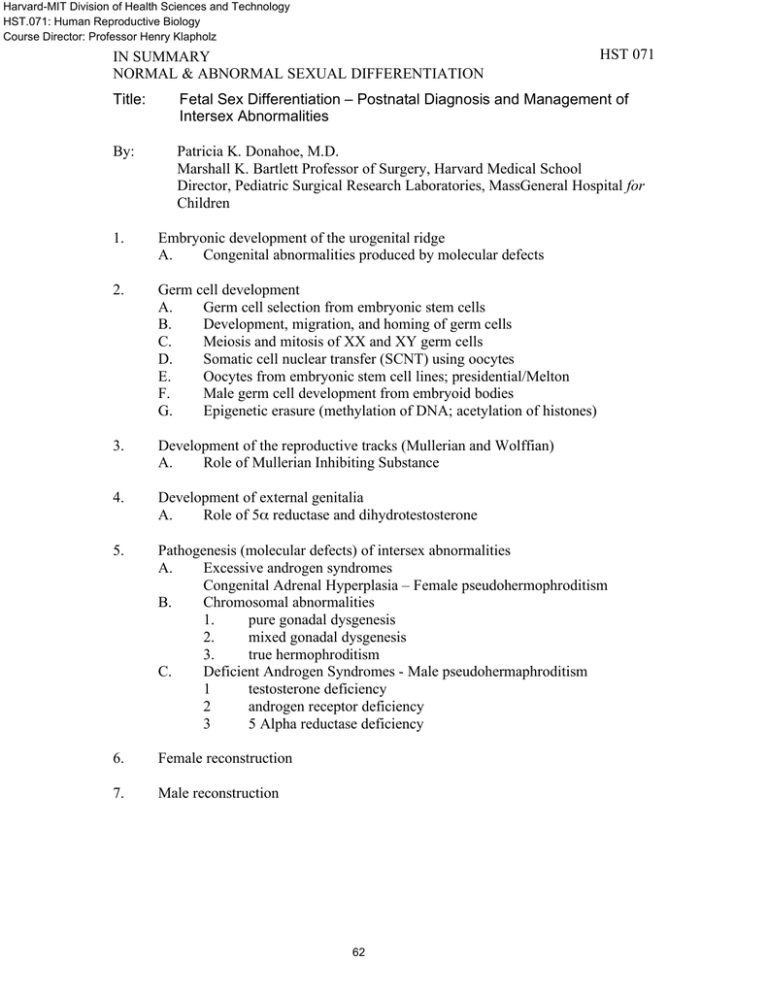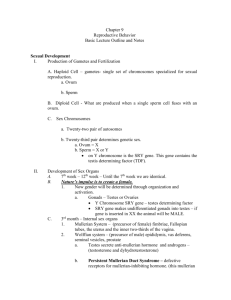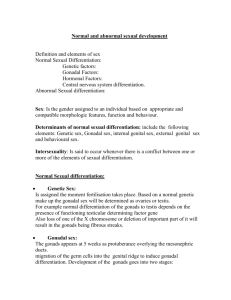Harvard-MIT Division of Health Sciences and Technology HST.071: Human Reproductive Biology
advertisement

Harvard-MIT Division of Health Sciences and Technology HST.071: Human Reproductive Biology Course Director: Professor Henry Klapholz IN SUMMARY NORMAL & ABNORMAL SEXUAL DIFFERENTIATION HST 071 Title: Fetal Sex Differentiation – Postnatal Diagnosis and Management of Intersex Abnormalities By: Patricia K. Donahoe, M.D. Marshall K. Bartlett Professor of Surgery, Harvard Medical School Director, Pediatric Surgical Research Laboratories, MassGeneral Hospital for Children 1. Embryonic development of the urogenital ridge A. Congenital abnormalities produced by molecular defects 2. Germ cell development A. Germ cell selection from embryonic stem cells B. Development, migration, and homing of germ cells C. Meiosis and mitosis of XX and XY germ cells D. Somatic cell nuclear transfer (SCNT) using oocytes E. Oocytes from embryonic stem cell lines; presidential/Melton F. Male germ cell development from embryoid bodies G. Epigenetic erasure (methylation of DNA; acetylation of histones) 3. Development of the reproductive tracks (Mullerian and Wolffian) A. Role of Mullerian Inhibiting Substance 4. Development of external genitalia A. Role of 5α reductase and dihydrotestosterone 5. Pathogenesis (molecular defects) of intersex abnormalities A. Excessive androgen syndromes Congenital Adrenal Hyperplasia – Female pseudohermophroditism B. Chromosomal abnormalities 1. pure gonadal dysgenesis 2. mixed gonadal dysgenesis 3. true hermophroditism C. Deficient Androgen Syndromes - Male pseudohermaphroditism 1 testosterone deficiency 2 androgen receptor deficiency 3 5 Alpha reductase deficiency 6. Female reconstruction 7. Male reconstruction 62 IN SUMMARY NORMAL & ABNORMAL SEXUAL DIFFERENTIATION HST 071 SEXUAL DIFFERENTIATION NORMAL SEXUAL DIFFERENTIATION • Embryo has bisexual potential, each gonad can develop into either testis or ovary • Orderly sequence needed for normal sexual differentiation of gonads, internal ductal system, and external genitalia • Psychosocial issues in intersex disorders may have more serious ramifications than physical ambiguity and sterility • delivering child with ambiguous genitalia should be considered medical emergency • Differences between male and female fetuses: - Testicular determinant genes must be present and active for testicular development to begin; ovarian determinant genes must be present at later stages • absence of testicular determinants, ovarian development will begin regardless of genetic sex of embryo - Male sexual differentiation depends on endocrine function of testes (testosterone, DHT, and MIS); female internal and external genital development occurs in absence of ovarian hormones • Note: Mullerian female; Wolffian male MALE SEXUAL DIFFERENTIATION • Initial switch seems to be Y-chromosome SRY gene • Primordial germ cells travel to genital ridge, become enveloped by developing seminiferous tubules • Sertoli cells at base of seminiferous tubules • Sertoli cells produce MIS (Mullerian inhibiting substance) • arrest of development of Mullerian system • Leydig cells appear and produce androgens • DHT has significantly greater potency than testosterone • Wolffian development due to testosterone because no 5-alpha-reductase to convert to DHT • External genital masculinization due to DHT (5-alpha-reductase present) • Competent androgen receptor needed for masculinization • Mullerian and Wolffian systems are local and unilateral - Remove one testis, that side develops Mullerian • External genital development begins week 9, completed in early middle trimester • Testicular descent week 32, gubernaculums “pulls” testis toward scrotum FEMALE SEXUAL DIFFERENTIATION • Ovarian development begins in absence of testicular or ovarian determinant genes • Mullerian development begins and continues unless arrested by MIS • External genitalia will feminize in absence of androgens • Ovaries contain 6 million germ cells by 20 weeks 63 IN SUMMARY NORMAL & ABNORMAL SEXUAL DIFFERENTIATION HST 071 DELETION SYNDROMES • Turner’s syndrome: X-chromosome deletion, 45X • Missing important ovarian determinant genes necessary for preservation of ovarian follicles • Bilateral streak gonads • Normal Mullerian and external genital development • Associated with coarctation of aorta and horseshoe kidney • 46XY gonadal dysgenesis (Swyer’s syndrome): - phenotypically normal female, delayed puberty, taller MULLERIAN INHIBITING SUBSTANCE DEFICIENCY • Testicular development and androgen production otherwise normal, normal penile development • Phenotypic males with uni- or bilateral cryptorchidism, testis contains Mullerian elements • Sterility may result • Agonadia (testicular regression syndrome): - 46XY, phenotypic female, normal MIS - blind vaginal pouch, absent internal genitalia and gonads = “empty pelvis syndrome” - defect in sexual differentiation after MIS elaboration, androgens not produced - likely environmental insult or vascular accident DEFECTS IN ANDROGEN BIOSYNTHESIS • 46XY, normal TDF (testicular determining factor) genes and MIS expression • normal testes, Mullerian regression • Steroid enzyme deficiency • suboptimal testosterone or DHT - Wolffian system development stimulated by testosterone - External genitalia depends on 5a-reductase and androgen receptor stimulation by DHT - • under masculinization and ambiguity • Sex of rearing usually female • 5a-reductase deficiency: female sex of rearing at birth, then masculinization at puberty because of high testosterone • 17a-hydroxylase deficiency may develop gynecomastia because of conversion of weak androgens to estrogen ANDROGEN INSENSITIVITY SYNDROME • Normal TDF genes, testicular development, MIS production, Mullerian regression, testicular androgen biosynthesis • Androgen receptor defect prevent end-organ masculinization in utero and at puberty • Mutation of X-located androgen receptor gene • Resistance to androgens • absent masculinization, vaginal pouch, spontaneous breast development at puberty, diminished pubic hair • Large breasts because no androgens to limit breast size • Tall stature TRUE HERMAPHRODITISM • Usually 46XX, less frequency 46XX/46XY (chimera), rarely 46XY • Usually unilateral ovary and contralateral testes • Chimera has two or more cells lines originating from different embryos • Ovarian component more developed • External genitalia under masculinized, breast development and menstruation common, should be raised as female SEX-REVERSED MALE • 46XX with Y DNA sequences translocated to X chromosome 64 IN SUMMARY NORMAL & ABNORMAL SEXUAL DIFFERENTIATION • • HST 071 Translocation of SKY, not genes controlling sperm production Male phenotype, infertile CONGENITAL ADRENAL HYPERPLASIA • Most common and serious abnormality of sexual differentiation, seen in 46XX • Deficiency of 21-hydroxylase or (less commonly) 11b-hydroxylase or 3b-hydroxysteroid dehydrogenase • Cortisol production limited • ACTH overproduction • accumulation of cortisol precursor and androgens • High fetal adrenal androgens adversely influence external genitalia in female but not male fetuses • virilization • Ranges from clitoromegaly and mild labioscrotal fusion through hypospadias • Bilateral undescended gonads with ambiguous penile development, think CAH • Tall children, short adults because of premature epiphyseal fusion • Skin hyperpigmentation because of high melanocyte stimulating hormone (MSH) • 21-OH deficiency: - Salt wasting and simple virilization - Males infants more likely to be undiagnosed and develop salt-wasting crisis than females, because normal phenotype at birth ANDROGEN EXCESS SYNDROME • In utero exposure to endogenous maternal or exogenous androgens can cause masculinization of the external genitalia • Placenta can aromatize native androgens, except DHT, to estrogen and prevent masculinization • Luteoma of pregnancy: androgen producing tumor IDENTIFICATION AND EVALUATION OF INTERSEX DISORDERS • Sex of rearing = label of male or female given at birth • Gender identity = one’s own feelings of sexuality • Ambiguous genitalia caused by intersex disorder may include: minimal clitoromegaly, isolated cryptorchidism, hypospadias, overt ambiguity • If gender is in question, best to withhold decision on sex of rearing • Can say “sexual development of this infant is incomplete; after a few studies it will be easy to determine whether the baby is a boy or girl” 65 HST 071 Content removed due to copyright restrictions. Please see: MacLaughlin, D. T., and P. K. Donahoe. "Sex Determination and Differentiation." �� N Engl J Med. 350, no. 4 (January 22, 2004) : 367-78. Erratum in N Engl J Med. 351, no. 3 (July 15, 2004): 306. : Comment in N Engl J Med. 350, no. 4 (January 22, 2004): 323-4. Engl J Med. 350, no. 21 (May 20, 2004): 2204-6, author reply 2204-6. FUNDAMENTAL QUESTIONS 1. How does the genital tract of a female fetus develop? 2. How does the genital tract of a male fetus develop? 3. What is the role of MIS? 4. What is the role of SRY? 5. How does mullerian agenesis occur? 6. What is a pseudohermaphrodite? 7. What is the role DHT in male development? 8. What is the androgen insensitivity syndrome? 9. What can congenital adrenal hyperplasia cause? Why? 10. What is the workup for CAH? 11. What is a true hermaphrodite? A pseudohermaphrodite? 12. What is androgen excess syndrome? 66 IN SUMMARY SEXUAL DIFFERENTIATION 67 IN SUMMARY SEXUAL DIFFERENTIATION 68





